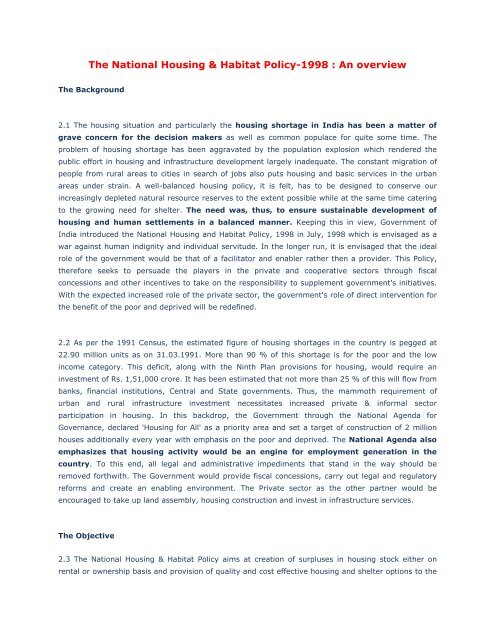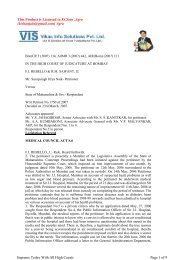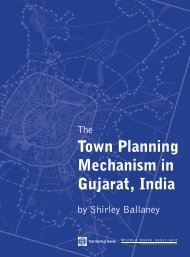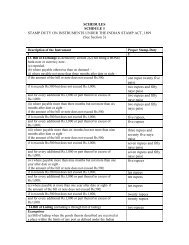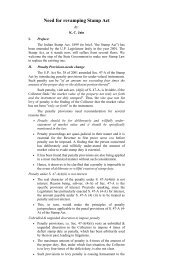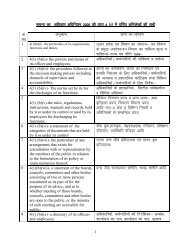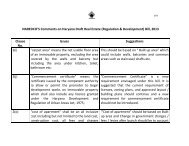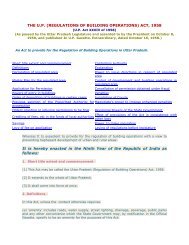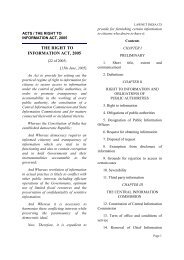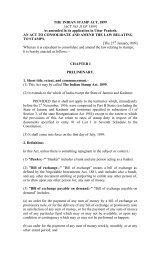The National Housing & Habitat Policy-1998 : An ... - Agra Redco
The National Housing & Habitat Policy-1998 : An ... - Agra Redco
The National Housing & Habitat Policy-1998 : An ... - Agra Redco
Create successful ePaper yourself
Turn your PDF publications into a flip-book with our unique Google optimized e-Paper software.
<strong>The</strong> <strong>National</strong> <strong>Housing</strong> & <strong>Habitat</strong> <strong>Policy</strong>-<strong>1998</strong> : <strong>An</strong> overview<br />
<strong>The</strong> Background<br />
2.1 <strong>The</strong> housing situation and particularly the housing shortage in India has been a matter of<br />
grave concern for the decision makers as well as common populace for quite some time. <strong>The</strong><br />
problem of housing shortage has been aggravated by the population explosion which rendered the<br />
public effort in housing and infrastructure development largely inadequate. <strong>The</strong> constant migration of<br />
people from rural areas to cities in search of jobs also puts housing and basic services in the urban<br />
areas under strain. A well-balanced housing policy, it is felt, has to be designed to conserve our<br />
increasingly depleted natural resource reserves to the extent possible while at the same time catering<br />
to the growing need for shelter. <strong>The</strong> need was, thus, to ensure sustainable development of<br />
housing and human settlements in a balanced manner. Keeping this in view, Government of<br />
India introduced the <strong>National</strong> <strong>Housing</strong> and <strong>Habitat</strong> <strong>Policy</strong>, <strong>1998</strong> in July, <strong>1998</strong> which is envisaged as a<br />
war against human indignity and individual servitude. In the longer run, it is envisaged that the ideal<br />
role of the government would be that of a facilitator and enabler rather then a provider. This <strong>Policy</strong>,<br />
therefore seeks to persuade the players in the private and cooperative sectors through fiscal<br />
concessions and other incentives to take on the responsibility to supplement government's initiatives.<br />
With the expected increased role of the private sector, the government's role of direct intervention for<br />
the benefit of the poor and deprived will be redefined.<br />
2.2 As per the 1991 Census, the estimated figure of housing shortages in the country is pegged at<br />
22.90 million units as on 31.03.1991. More than 90 % of this shortage is for the poor and the low<br />
income category. This deficit, along with the Ninth Plan provisions for housing, would require an<br />
investment of Rs. 1,51,000 crore. It has been estimated that not more than 25 % of this will flow from<br />
banks, financial institutions, Central and State governments. Thus, the mammoth requirement of<br />
urban and rural infrastructure investment necessitates increased private & informal sector<br />
participation in housing. In this backdrop, the Government through the <strong>National</strong> Agenda for<br />
Governance, declared '<strong>Housing</strong> for All' as a priority area and set a target of construction of 2 million<br />
houses additionally every year with emphasis on the poor and deprived. <strong>The</strong> <strong>National</strong> Agenda also<br />
emphasizes that housing activity would be an engine for employment generation in the<br />
country. To this end, all legal and administrative impediments that stand in the way should be<br />
removed forthwith. <strong>The</strong> Government would provide fiscal concessions, carry out legal and regulatory<br />
reforms and create an enabling environment. <strong>The</strong> Private sector as the other partner would be<br />
encouraged to take up land assembly, housing construction and invest in infrastructure services.<br />
<strong>The</strong> Objective<br />
2.3 <strong>The</strong> <strong>National</strong> <strong>Housing</strong> & <strong>Habitat</strong> <strong>Policy</strong> aims at creation of surpluses in housing stock either on<br />
rental or ownership basis and provision of quality and cost effective housing and shelter options to the
citizens, specially the vulnerable group and the poor. <strong>The</strong> <strong>Policy</strong> emphasises on increased use of<br />
renewable energy sources and pollution free atmosphere with a concern for solid waste disposal and<br />
intends to exploit the potential of the housing sector to achieve skill up-gradation in housing and<br />
building activity. In order to make a progressive shift from a subsidy based housing scheme to cost<br />
sharing or Cost recovery-cum-subsidy schemes for rural housing, it is required to remove legal,<br />
financial and administrative barriers for facilitating access to land, finance and technology. This would<br />
require, on one hand, empowerment of the Panchayati Raj Institutions and village cooperatives to<br />
mobilise credit for adding to the housing stock and also basic amenities in the rural areas, on the<br />
other, a strong partnerships between private, public and cooperative sectors would enhance the<br />
capacity of the construction industry to participate in every sphere of housing and habitat.<br />
2.4 <strong>The</strong> <strong>Policy</strong> also envisages to meet the special needs of the backward and socially oppressed<br />
classes and to engage women at all levels of decision making with a view to lighten their<br />
drudgery in homes. It also intends to preserve and promote our cultural heritage, architecture and<br />
traditional skills. Besides, establishment of a Management Information System in the housing sector to<br />
strengthen monitoring of building activity in the country is also expected to serve as a decision<br />
support system.<br />
Government as the Facilitator<br />
2.4 <strong>The</strong> <strong>Policy</strong> envisages that the Central Government would take steps to bring. in legal reforms<br />
including formulation of effective foreclosure laws and devise macro economic policies to enable flow<br />
of resources and technology transfer to the housing and infrastructure sector. <strong>The</strong> Government<br />
envisages to evolve parameters for optimal use of available resources keeping in view the crucial issue<br />
of ecological balance in the environment and towards this end, it is to provide fiscal concessions for<br />
housing, infrastructure, innovative and energy saving construction materials and methods and also to<br />
set up a regulatory mechanism to ensure that the concessions are correctly targeted and utilised. Most<br />
significantly, the <strong>Policy</strong> envisages the role of the Government as the promoter of a secondary<br />
mortgage market for housing finance in the country to combat the growing need for resources in the<br />
fund-deficient housing sector.<br />
2.5 <strong>The</strong> State Governments are also expected to come forward by way of liberalizing the legal and<br />
regulatory regime to give a boost to housing and supporting infrastructure and promote participation<br />
of private sector and cooperatives in housing activities. <strong>The</strong> immediate task in hand for the State<br />
Governments would be to undertake appropriate reforms for easy access to land and promote<br />
decentralised production and availability of building material. State Governments are also expected to<br />
facilitate training of construction workers by converging other development programmes through<br />
Building Centres and other agencies and empower the local bodies to discharge their responsibilities in<br />
regulatory and development functions. <strong>The</strong> full potential of 73rd and 74th Constitutional Amendments<br />
is envisaged to be utilised.
Other Agencies<br />
2.6 <strong>The</strong> <strong>Policy</strong> envisages the role for local bodies to identify specific housing shortages and<br />
devise programmes to meet housing shortages and augment supply of land for housing,<br />
particularly for the vulnerable group. State Governments would also prepare District <strong>Housing</strong><br />
Action Plans for rural areas and enforce effective regulatory measures for planned development. <strong>The</strong><br />
housing finance institutions [HFIs] are expected to redefine their role and move away from their<br />
traditional approach to housing finance. <strong>Housing</strong> finance companies are required to adopt a more<br />
flexible approach and modify the present system of collateral, assessment of repayment capacity and<br />
system of creating mortgages. <strong>Housing</strong> finance companies may also earmark a part of their resource<br />
for rural housing projects. <strong>The</strong>y are expected to develop the requisite skills to mobilize domestic<br />
savings through innovative methods. <strong>The</strong>se dedicated institutions are expected to devise schemes to<br />
lend at affordable rates to those who are in need of housing finance support and to cover the poorer<br />
segments who depend on the informal sector. <strong>An</strong>y fiscal concession to HFIs or other support from<br />
Government would be linked to their readiness to finance the needy and the poor.<br />
Supply Side Innovations<br />
2.7 Extensive research needs to be undertaken to innovate cost-effective, environment friendly and<br />
energy efficient construction materials and technologies which would be responsive to the different<br />
climatic conditions in the country. Disaster mitigation techniques for new constructions as well as<br />
strengthening of existing houses are an urgent necessity to prevent continuing loss of housing stock<br />
and human lives from major natural hazards like earthquakes, cyclones and floods. Towards this end,<br />
in the rural areas it is proposed that shelter related forestry could be taken up with faster recycling on<br />
wasteland and other land unsuitable for agriculture. This would generate substantial employment also.<br />
Similarly watershed development must be accelerated to conserve water, stop soil erosion and regenerate<br />
tree cover<br />
Land<br />
2.8 Availability of usable land at affordable rates is the most critical input for housing. <strong>The</strong> <strong>Policy</strong><br />
makes room for Public agencies to undertake land acquisition proceedings for housing and urban<br />
services. Other more feasible alternatives like land sharing and land pooling arrangements,<br />
particularly in the urban fringes, would be considered through public and private initiatives with<br />
appropriate statutory support. Land assembly and development by the private sector and optimization<br />
of urban land use, in turn, call for suitable amendment to town and country planning regulations.<br />
Finance<br />
2.9 Affordable finance is the next most critical input for housing and infrastructure services.<br />
<strong>The</strong>refore, it is imperative to develop a debt market for housing and infrastructure, fully integrated
with the financial markets in the country. Thus, mortgage backed securitisation and development of a<br />
secondary mortgage market in the country is essential to provide and recycle finance for the housing<br />
sector. This would release the funds of HFIs locked up in mortgages and augment their capacity to<br />
provide more finance. <strong>The</strong>se HFIs can also tap the resources from provident funds, insurance funds,<br />
mutual funds etc. Towards this end, the <strong>Policy</strong> pronounces the creation of a secondary mortgage<br />
market by the <strong>National</strong> <strong>Housing</strong> Bank in its capacity as the apex institution for housing finance in the<br />
country.<br />
2.10 <strong>The</strong> <strong>Policy</strong> also envisages that a <strong>National</strong> Shelter Fund be set up to meet the requirement of low<br />
cost funds for the housing needs of the Poor. Fiscal concessions would be provided to the corporate<br />
sector for contributing to this Fund. <strong>The</strong> building material industry would also contribute to the corpus.<br />
Besides, the Government would consider setting up of a Risk Fund to underwrite or cover the risk in<br />
financing the rural and urban poor, considered risky by HFIs, if the exigencies of the situation so<br />
demand. This Fund would be built up by HFIs by surrendering a part of their profits.<br />
2.11 Banks would also be asked to step up the quantum of funds being released under the priority<br />
sector for housing. Banks would be persuaded to consider fixing targets for disbursement of funds<br />
under priority sector for housing for the vulnerable group. Investment from Non Resident<br />
Indians/Persons of Indian Origin/Overseas Corporate Bodies would be encouraged in housing, real<br />
estate and infrastructure sectors. Foreign direct investment would be welcome in housing and<br />
infrastructure sectors consistent with national interests.<br />
Legal and Regulatory Reforms<br />
2.12 It is envisaged that legal and Regulatory reforms would form the backbone of housing activity as<br />
government becomes more of an enabler and creates a suitable environment for the private sector<br />
and others to shoulder more responsibility in the sector. Thus, it has been decided to repeal the Urban<br />
Land Ceiling Act to correct the distortions in the land market. <strong>The</strong> procedure of sanctioning building<br />
plans is to be made simplified to eradicate corrupt practices and professional responsibility will be<br />
vigorously enforced with heavy punishment imposed for false certification.<br />
2.13 Rent Control Legislations in the States would need to be amended to stimulate investment in<br />
rental housing which is the viable shelter option for the low income groups in large and medium cities.<br />
New constructions should be specifically excluded from Rent Control in order to encourage investment<br />
in Rental <strong>Housing</strong>. Some states have taken steps to reform their Rent Control Acts. However most of<br />
the states have yet to bring in the rent control reforms. In case these States face difficulties, the<br />
Union Government could consider framing a <strong>National</strong> Rent Control Legislation to apply to these states.<br />
2.14 It is required that a land acquisition legislation would be drawn up for the urban areas.<br />
Alternatively, the existing Land Acquisition Act would be suitably amended. <strong>The</strong> concerned Town<br />
Planning laws and land-use regulations also are required to be amended to provide<br />
statutory support for land assembly, land pooling and sharing arrangements. It is imperative
to amend foreclosure laws in the country for speedy foreclosure procedures in case of defaults.<br />
<strong>The</strong> <strong>National</strong> <strong>Housing</strong> Bank Act would be amended to facilitate this. <strong>The</strong> Transfer of Property Act would<br />
also be amended if necessary. Besides, the Acts relating to the Insurance sector would be<br />
amended to facilitate Mortgage Insurance in the country. In the same lines of all these proposed<br />
amendments, a special chapter on housing cooperatives would be added to the Cooperative laws in<br />
the States. States will be strongly advised to rationalise the scale of stamp duty to eliminate<br />
large scale evasion. <strong>The</strong>y would also be advised to reduce the stamp duty on mortgage backed<br />
securitisation to help in setting up the secondary mortgage market. Besides, the states would be<br />
persuaded to simplify registration procedures in the conveyance of immovable properties. Since the<br />
housing activities in large towns and cities are increasingly taking the form of apartments and<br />
condominiums, the States would be persuaded to enact Apartment Ownership Legislations.<br />
Technology<br />
2.15 <strong>The</strong> primary aim of technological innovations and technology transfer should be to<br />
provide affordable shelter for the poor. <strong>The</strong> government would take an active lead in promoting<br />
and using building materials and components based on agricultural and industrial waste, particularly<br />
those based on fly ash, red mud, etc. besides reducing the use of scarce natural resources. In order to<br />
reduce energy consumption and pollution, low energy consuming construction techniques and<br />
materials would be used. Similarly the energy needed in providing lighting, ventilation , heating<br />
cooling and other services in buildings would need to be minimised so as to reduce overall energy<br />
consumption.<br />
2.16 <strong>The</strong>re are certain regions in the country which are prone to natural calamities like earthquake,<br />
floods and cyclones. <strong>The</strong> Code for disaster resistant construction and land use planning would<br />
be observed and enforced without exception besides augmenting public awareness in this area. With a<br />
futuristic outlook, the <strong>Policy</strong> proposes that innovative building materials, construction techniques and<br />
energy optimising features should be an integral part of curricula in engineering colleges and training<br />
institutions. Government would promote use of such innovative and eco-friendly materials<br />
through fiscal concessions and levy concessional tax on such materials which are high consumers of<br />
energy.<br />
Sustainability<br />
2.17 In order to guarantee a balanced and sustainable growth, the scarce natural resources need to<br />
be conserved and utilised in a prudent manner. Thus, human settlements would be planned in a<br />
manner which minimizes energy consumption in transportation, water supply and other<br />
services. Decongestion of metro and mega cities is urgently needed through development of<br />
satellite townships which would also help in stemming uncontrolled migration leading to<br />
unmanageable densities in the large cities.<br />
Employment
2.18 <strong>The</strong> housing sector provides employment to 16 % of the work force (absolute number 146 lakhs<br />
- 1997). It is growing at the rate of 7 %. Out of this, the housing sector alone accounts for 85.5 lakhs<br />
workers. However, nearly 55 % of them are in the unskilled category. <strong>The</strong>refore, skill up-gradation<br />
would result in higher income for the sector. <strong>The</strong> workers also need to be trained to keep up with the<br />
technological advancement in this sector.<br />
2.19 <strong>The</strong> building industry is the biggest employer of women workers and is perhaps their biggest<br />
exploiter in terms of gender disparity in wages. <strong>The</strong> solution lies in skill upgradation and induction of<br />
women at supervisory levels and also encouraging women as contractors. This can be materialised<br />
with active support from public agencies and preferential treatment extended to women by the<br />
training institutions. It is also expected of the concerned authorities to make adequate provisions for<br />
the safety and health of women engaged in hazardous construction activities.<br />
2.20 In line with the national policy to prohibit the evil practice of child labour the exploitation of<br />
children in the construction sector will be strictly banned. Appropriate steps would be taken to<br />
provide them with educational and other facilities for their healthy growth.<br />
Other issues<br />
2.21 <strong>The</strong> planning and design of buildings and public places must take care of the needs of<br />
persons with disabilities. Allotment of Government accommodation should provide preferential<br />
treatment to the families belonging to the Scheduled Castes/Scheduled Tribes communities.<br />
2.22 <strong>The</strong> Government would encourage setting up an independent rating agency for<br />
builders/promoters to inspire public confidence in, their activities. Similarly, a professional body<br />
would be needed to undertake demand assessment and survey for housing projects. This step would<br />
help in reducing speculative pressures created in the land and the housing market. <strong>The</strong> housing<br />
finance institutions, while financing a project or the local authorities while approving a project, would<br />
take into account such independent assessment.<br />
2.23 Relocation of industrial units which provide substantial employment would be considered in<br />
the context of regional planning so as to avoid over-congestion of the large and metro cities. <strong>The</strong><br />
Corporates should provide housing for employees as a part of their industrial projects. Fiscal<br />
concessions could be provided to them.<br />
2.24 <strong>The</strong> nation-wide Management information System (MIS) on house building activities would<br />
be strengthened to help in designing and developing housing programmes and also assist in decision<br />
making. <strong>The</strong> Ultimate goal of this 'Shelter to All' is to ensure that the basic necessities of all citizens<br />
are taken care of and a better quality of life is assured for all.


